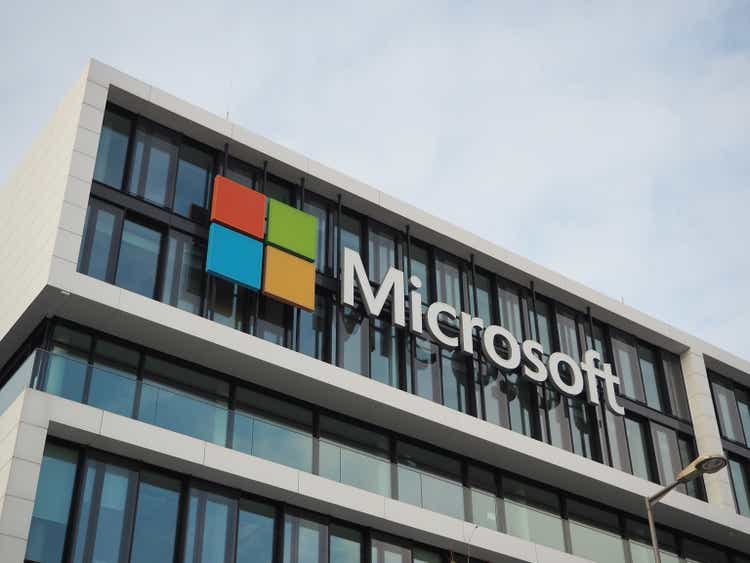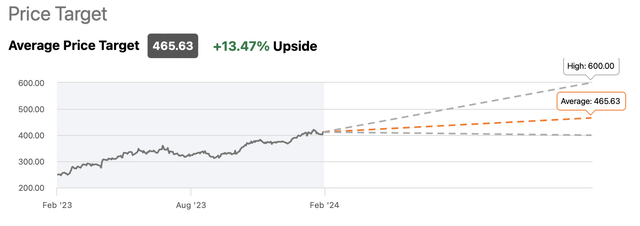Summary:
- Microsoft has been exceeding the expectations in recent months thanks to the implementation of AI tools at scale across every layer of its tech stack.
- Microsoft has everything going for it to retain its momentum and continue to exceed expectations over the coming quarters.
- However, the lack of a margin of safety could make opening a position at the current price a risky endeavor.
FinkAvenue
Microsoft (NASDAQ:MSFT) continues to aggressively exceed expectations as its dominance in the generative AI field along with the expanding subscriber base made the company report great earnings results a few weeks ago. Going forward, it seems that nothing will be able to undermine Microsoft’s growth story as the expanding number of new opportunities are likely to outweigh most of the risks associated with the company and its stock. However, the lack of a margin of safety could make opening a position at the current price a risky endeavor.
Is Microsoft Unstoppable?
Back in October, I wrote my latest article on Microsoft in which I highlighted how the company is likely to continue to scale its operations thanks to the release of several generative AI products that could have a positive effect on the business’s performance in the following quarters. That’s exactly what has happened since that time, as the latest earnings report for Q2 that was released a few weeks ago showed that Microsoft’s revenues during the recent quarter increased by 17.7% Y/Y to $62.02 billion, above the estimates by $890 million. On top of that, the GAAP EPS was $2.93, also above the estimates, as the net income increased by 33% Y/Y to $21.9 billion.
Going forward, it’s safe to assume that Microsoft will be able to continue to generate such impressive results. This is due to the fact that the company has strong pricing power along with a loyal client base in the consumer and enterprise software field, and due to its ability to meet the growing demand for generative AI by integrating various AI tools into its existing products. It’s no surprise that Microsoft’s latest conference call was all about how the company has started to apply AI at scale across every layer of its tech stack to drive growth. Considering that the revenues from the Productivity and Business Processes business and More Personal Computing business increased in Q2 by 13% and 19% to $19.2 billion and $16.9 billion, respectively, it makes sense to say that the company’s efforts in the AI field so far have been successful.
At the same time, the addition of Microsoft’s Copilot chatbot into most of the company’s flagship products is also likely to help the company deliver a stellar performance in the following quarters and end the fiscal year on a high note. With an indication that the majority of Microsoft’s installed base is interested in implementing various AI tools at a time when IT spending is expected to grow to new records, it makes sense to believe that the company’s growth story is not over yet.
What’s more, is that the rising demand for AI helped Microsoft increase its cloud revenues by 20% Y/Y to $25.9 billion and grow its market share to an all-time high of 24%, closely trailing behind Amazon (AMZN) with its 31% market share. Since the cloud market is expected to grow at a CAGR of 16.4% and reach $1.44 trillion by 2029, it makes sense to assume that Microsoft will become one of the biggest beneficiaries of such rapid growth given its latest advancements in generative AI.
On top of all the buzz about AI, it’s also important to note that the company’s gaming division is slowly becoming another money-making machine for Microsoft with the potential to continue to aggressively grow revenues with each passing quarter. After finally completing the acquisition of Activision, Microsoft’s Xbox business managed to set a new record of having 200 million MAUs and added hundreds of millions of new users to its ecosystem. Back in 2022, I explained in great detail why the acquisition made perfect sense for Microsoft and how its strategy in the gaming business could lead to the creation of additional shareholder value in years to come. The company’s latest moves to create an extensive library of content and sell it under the subscription model not only on Xbox but also on other consoles and cloud services makes perfect sense in my opinion, as it makes it possible for Microsoft to reach a wider audience and add new users into its ecosystem at scale.
All of those growth catalysts make it possible for Microsoft to continue to generate aggressive returns and exceed expectations in the following quarters. Thanks to its dominant position in different categories, the street expects Microsoft to generate double-digit earnings and revenue returns in the next few years, and recently even made dozens of upward revisions due to the strong guidance that the management has recently issued. Add to all of this the fact that Microsoft’s stock was able to retain its momentum in recent weeks, and it makes sense to believe that the company has everything going for it to achieve the street’s consensus price target of ~$465 per share in the following weeks.
Microsoft’s Consensus Price Target (Seeking Alpha)
Lack Of Margin Of Safety Is A Major Concern
While Microsoft’s stock was able to significantly appreciate in recent weeks, retain its momentum, and even has a chance to achieve the street’s price target in the foreseeable future, there are questions about whether it makes sense to accumulate a position at this stage. The biggest issue with Microsoft’s stock right now is the lack of margin of safety.
Currently, the company has a forward P/E of ~35x, which is significantly above its Big Tech peers such as Meta Platforms (META) and Google (GOOG)(GOOGL) which have a forward P/E ratio of ~24x and ~22x, respectively. The average P/E of the S&P 500 index is ~28x, which indicates that Microsoft is greatly overvalued against its peers and the broader market at the same time. What’s more, is that the upside that its shares represent is fairly limited, while Seeking Alpha’s Quant system gives the company a rating of HOLD instead of BUY primarily because of its current valuation. Therefore, now might not be a good time to open a position in the company after the latest rally. If we witness a pullback in the following weeks that brings the P/E to below 30x, then the margin of safety would be much greater and would justify accumulating a long position then.
At the same time, the valuation story is not the only worry. Even though we’ve managed to avoid a recession and it appears that the soft landing is on the cards, the external risks caused by various geopolitical developments could nevertheless have a direct impact on the global economy and affect consumers. On the one hand, the rising tensions in the Middle East have already resulted in a surge of shipping costs to the pandemic levels and could negatively start affecting consumers in the following months as the Red Sea crisis appears to be far from over. In addition to that, the potential further reduction of oil production by OPEC+ along with the rising tensions in South America could push the oil prices higher and prompt the monetary authorities to hold rates higher for longer. On top of that, the potential deflation in China could also have a domino effect around the globe and negatively affect consumers. All of those potential events have a relatively high probability of happening and could negatively affect Microsoft’s performance in the following quarters.
The Bottom Line
By looking at Microsoft’s business performance in recent quarters and the number of positive catalysts that the company still has, it makes sense to believe that the company’s growth story is far from over. Considering that the overall macro picture is likely to continue to improve over the coming months, Microsoft has everything going for it to retain its momentum and continue to exceed expectations over the coming quarters.
The only issue that I have with Microsoft is the rapid appreciation of its shares in recent months, which made the company overvalued in comparison to the broader market and some other Big Tech names. That’s why even though I think that the company has additional room for growth, accumulating shares on major pullbacks is the only reasonable way to generate decent returns and minimize risks at the same time. Buying at a P/E below of 30x would make more sense as then the company would be trading closer to its peers and give investors greater margin of safety.
This is the main reason why I’m sticking with my HOLD rating for now, and will likely change it to BUY if the major pullback happens and drags shares to lower levels where they will be trading at multiples similar to their Big Tech peers.
Analyst’s Disclosure: I/we have no stock, option or similar derivative position in any of the companies mentioned, and no plans to initiate any such positions within the next 72 hours. I wrote this article myself, and it expresses my own opinions. I am not receiving compensation for it (other than from Seeking Alpha). I have no business relationship with any company whose stock is mentioned in this article.
Bohdan Kucheriavyi is not a financial/investment advisor, broker, or dealer. He's solely sharing personal experience and opinion; therefore, all strategies, tips, suggestions, and recommendations shared are solely for informational purposes. There are risks associated with investing in securities. Investing in stocks, bonds, options, exchange-traded funds, mutual funds, and money market funds involves the risk of loss. Loss of principal is possible. Some high-risk investments may use leverage, which will accentuate gains & losses. Foreign investing involves special risks, including greater volatility and political, economic, and currency risks and differences in accounting methods. A security’s or a firm’s past investment performance is not a guarantee or predictor of future investment performance.
Seeking Alpha’s Disclosure: Past performance is no guarantee of future results. No recommendation or advice is being given as to whether any investment is suitable for a particular investor. Any views or opinions expressed above may not reflect those of Seeking Alpha as a whole. Seeking Alpha is not a licensed securities dealer, broker or US investment adviser or investment bank. Our analysts are third party authors that include both professional investors and individual investors who may not be licensed or certified by any institute or regulatory body.
